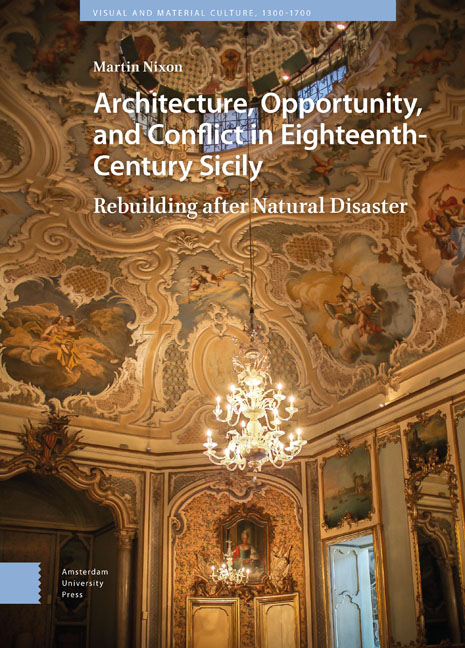 Architecture, Opportunity, and Conflict in Eighteenth-Century Sicily
Architecture, Opportunity, and Conflict in Eighteenth-Century Sicily Book contents
- Frontmatter
- Contents
- List of illustrations
- Acknowledgments
- Introduction: The Val di Noto Rebuilding: Disaster and Opportunity
- 1 Sicily as a Colonial Possession c. 1600–1750: Subordination and Resistance
- 2 The Hexagonal Towns of Avola and Grammichele : Urbanism, Fortification, and Coercion
- 3 The Palaces of Noto: Ornament, Order, and Opportunism
- 4 The Palazzo Biscari in Catania: Lightness, Refinement, and Distinction
- 5 The Palazzo Beneventano in Scicli: Trauma and Violence
- 6 The Palaces of Ragusa: Abundance, Famine, and the Grotesque
- Conclusion
- Glossary
- Bibliography
- Index
Introduction: The Val di Noto Rebuilding: Disaster and Opportunity
Published online by Cambridge University Press: 24 November 2023
- Frontmatter
- Contents
- List of illustrations
- Acknowledgments
- Introduction: The Val di Noto Rebuilding: Disaster and Opportunity
- 1 Sicily as a Colonial Possession c. 1600–1750: Subordination and Resistance
- 2 The Hexagonal Towns of Avola and Grammichele : Urbanism, Fortification, and Coercion
- 3 The Palaces of Noto: Ornament, Order, and Opportunism
- 4 The Palazzo Biscari in Catania: Lightness, Refinement, and Distinction
- 5 The Palazzo Beneventano in Scicli: Trauma and Violence
- 6 The Palaces of Ragusa: Abundance, Famine, and the Grotesque
- Conclusion
- Glossary
- Bibliography
- Index
Summary
In January 1693, one of Italy's most powerful recorded earthquakes struck the Val di Noto area of south-eastern Sicily. There were two shocks, one on 9 January and another on 11 January. The earthquake killed approximately 60,000 people, slightly more than one in five of an estimated population of around 260,000. Some eyewitnesses described the horror as God's visitation on the people, with portents appearing before the earthquakes. Connecting the earthquake with divine castigation, the author of one report to the Spanish king, Sicily's colonial ruler, claimed that ‘the processions and bitter penitences being made have no parallel anywhere in the world’.
Around 60 towns were affected overall. Catania, the area's largest city, lost over 80 per cent of its population. Of the other large towns, Ragusa lost half its population and Syracuse and Noto lost a quarter. Catania and Noto were completely destroyed, and Ragusa, Syracuse, and Modica suffered significant damage. Medium-sized towns, such as Avola and Scicli, and many smaller centres were also left in ruins. Looking back on these events 70 years later, Arcangelo Leanti's Lo stato presente della Sicilia (Palermo, 1761), a compendium on the history and geography of the island, concludes:
The horrible earthquake of 1693 was without any doubt the biggest and will always be the most memorable in the annals of this island. It resulted in the great tremor, and especially in the Val di Noto the ruin of many cities and lands, to the number of 60, and the deaths of 70,000 people.
Rebuilding after earthquakes is part of the history of many Sicilian towns, but the reconstruction of so many centres after 1693 was a major architectural undertaking. The amount of new construction is comparable to such projects as Saint Petersburg, built between 1703 and the 1720s, or the rebuilding of Lisbon after the 1755 earthquake. The Val di Noto reconstruction resulted in hundreds of new buildings and townscapes, and completely new locations for eight towns. Its effects continued far into the eighteenth century. Many buildings rebuilt after 1693, such as the Palazzo Biscari in Catania, the Palazzo Nicolaci in Noto, or the cathedral of Modica, were only completed 60 or more years later. Although eight of the rebuilt towns are part of a UNESCO heritage area, the remarkable architecture resulting from this rebuilding is little known outside Sicily.
- Type
- Chapter
- Information
- Architecture, Opportunity, and Conflict in Eighteenth-Century SicilyRebuilding after Natural Disaster, pp. 15 - 28Publisher: Amsterdam University PressPrint publication year: 2023


